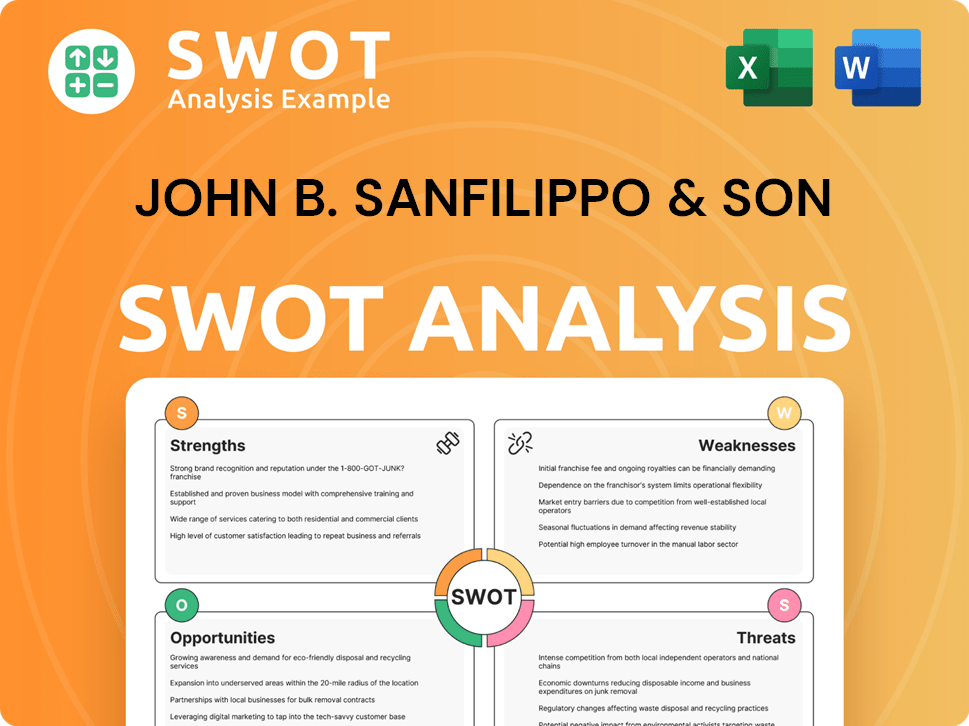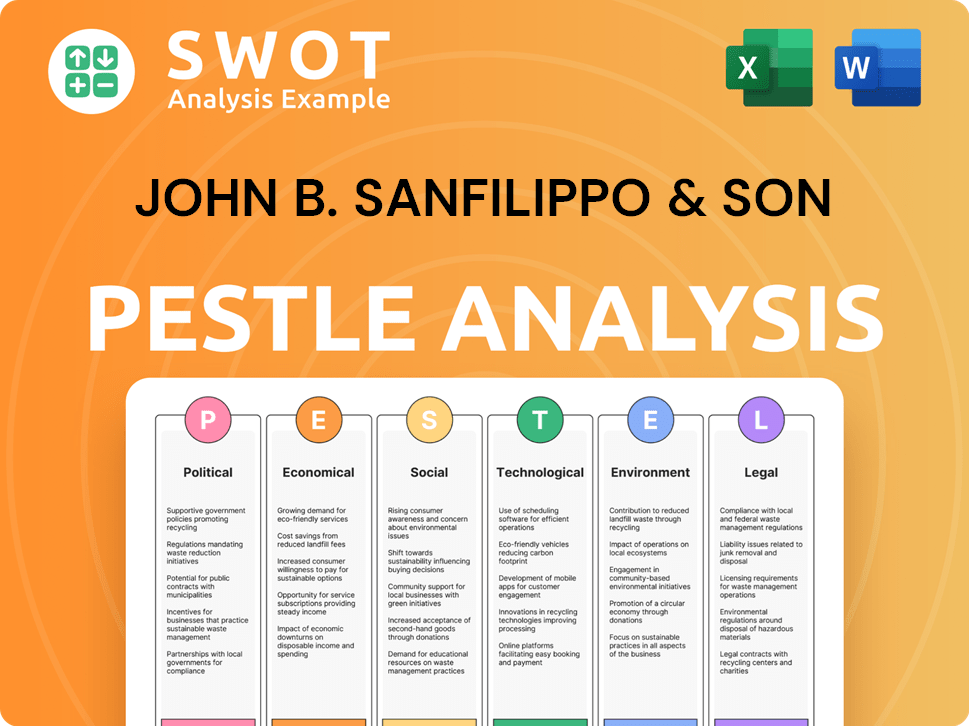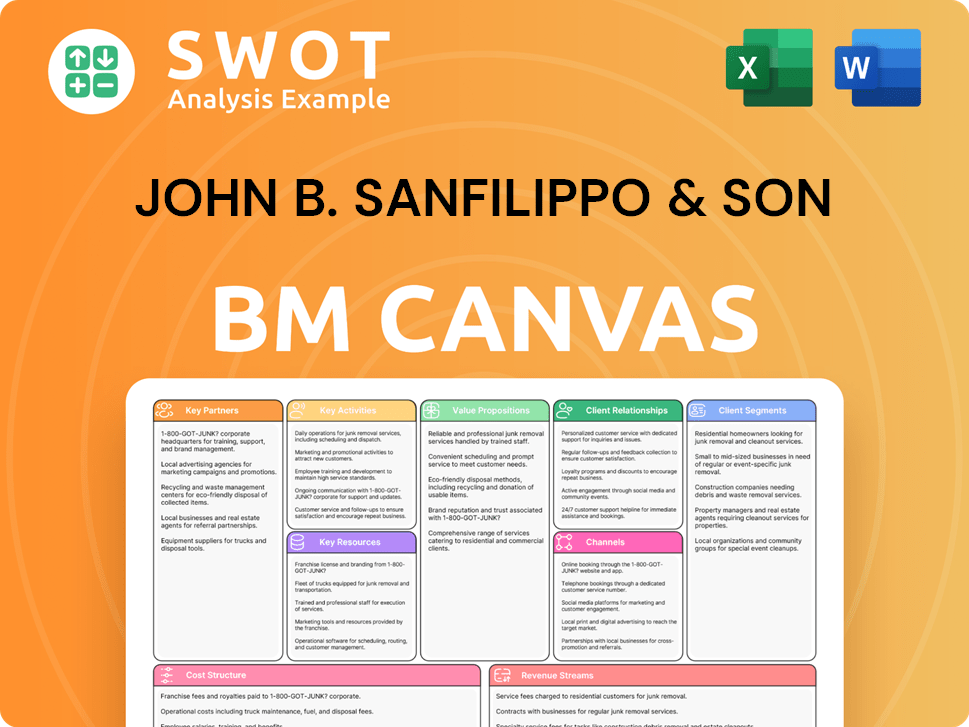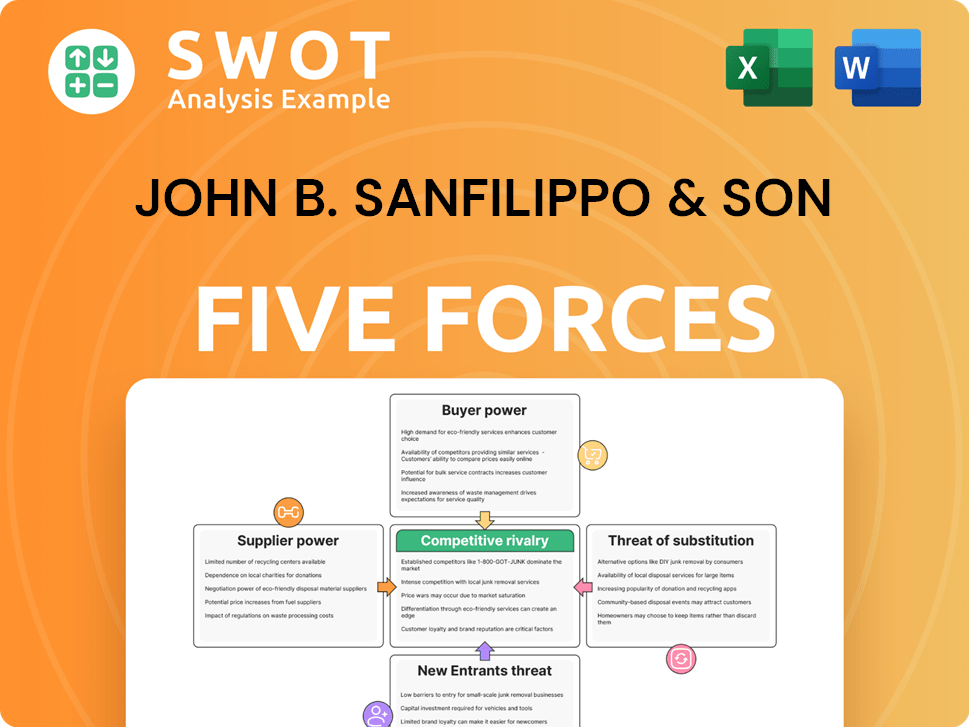John B. Sanfilippo & Son Bundle
Can John B. Sanfilippo & Son Crack the Code to Sustained Growth?
John B. Sanfilippo & Son (JBSS), a titan in the nut and dried fruit market, is navigating a dynamic landscape, fueled by strategic acquisitions and evolving consumer preferences. Their recent acquisition of the TreeHouse Foods snack bar business marks a pivotal moment, propelling JBSS past the $1 billion annual net sales milestone in fiscal year 2024. But what's next for this established player, and how does their John B. Sanfilippo & Son SWOT Analysis shape their future?

This deep dive explores the John B. Sanfilippo & Son growth strategy, examining their expansion strategies, innovation pipeline, and financial projections. We'll dissect the JBSS competitive landscape, including market trends and consumer behavior, to understand how the company aims to capitalize on investment opportunities and ensure long-term shareholder value. Understanding the future prospects of John B. Sanfilippo & Son requires a close look at their sustainability initiatives and supply chain management.
How Is John B. Sanfilippo & Son Expanding Its Reach?
The expansion strategy of John B. Sanfilippo & Son (JBSS) centers on strategic acquisitions, broadening distribution channels, and growing its private brand portfolio. These initiatives aim to boost the company's market presence and financial performance. Understanding these strategies is key to assessing the future prospects of JBSS and its position within the nut industry.
A significant aspect of JBSS's growth involves diversifying its product offerings through acquisitions. This approach not only expands the company's portfolio but also helps capture a larger share of the market. The focus on distribution and private brands further supports JBSS's strategic goals.
For a deeper dive into the company's financial structure, consider exploring the Revenue Streams & Business Model of John B. Sanfilippo & Son.
The acquisition of the TreeHouse Foods snack bar business, completed on September 29, 2023, was a pivotal move. This acquisition was instrumental in diversifying JBSS's product offerings. It contributed approximately $120 million to net sales in fiscal year 2024, out of a total of $131 million generated by their snack and nutrition bar offering. This acquisition significantly boosted JBSS's presence in the snack market.
JBSS is actively working to broaden the distribution of its private brand snack and nutrition bars. In the first quarter of fiscal year 2025, the consumer distribution channel saw a 30.8% increase in sales volume. Excluding the Lakeville acquisition, the increase was 3.4%. This growth was also fueled by a 27.6% increase in bars volume in the second quarter of fiscal year 2025.
JBSS is expanding its manufacturing capabilities to support its growth. The company leased a new 400,000-square-foot warehouse in Huntley, Illinois. This new facility will free up about 250,000 square feet at existing facilities for increased production of bars and nut and trail mix packaging. The consolidation of Elgin and Lakeville distribution operations into the Huntley facility is planned for the second half of fiscal year 2025.
A key element of JBSS's expansion strategy is the growth of its private brand portfolio. This includes increasing distribution channels and expanding manufacturing capacity. These initiatives are designed to enhance JBSS's market share and profitability in the long term. The company's focus on private brands is a strategic move to meet consumer demand.
JBSS's expansion strategies are multifaceted, involving acquisitions, distribution channel enhancements, and manufacturing capacity expansions. These initiatives are designed to drive John B. Sanfilippo & Son's growth strategy and improve its future prospects.
- Strategic acquisitions, such as the TreeHouse Foods snack bar business, diversify product offerings and increase revenue.
- Expanding distribution channels, particularly for private brand products, boosts market penetration.
- Enhancing manufacturing and logistics capabilities supports increased production and efficient distribution.
- The new Huntley, Illinois facility will streamline operations and increase production capacity.
John B. Sanfilippo & Son SWOT Analysis
- Complete SWOT Breakdown
- Fully Customizable
- Editable in Excel & Word
- Professional Formatting
- Investor-Ready Format

How Does John B. Sanfilippo & Son Invest in Innovation?
The innovation and technology strategy of John B. Sanfilippo & Son (JBSS) is a core element of its Growth Strategy, focusing on operational efficiencies, new product development, and sustainable practices. This approach is designed to enhance the company's market position and ensure long-term success. The company's commitment to innovation is evident in its significant investments and strategic initiatives.
JBSS is actively leveraging technology to drive improvements across various aspects of its operations. This includes the implementation of Artificial Intelligence (AI) to boost system and process efficiencies. These efforts are part of a broader strategy to optimize operations, reduce costs, and enhance overall productivity.
The company's dedication to innovation extends to its product development. In 2024, JBSS launched seven new product innovations, demonstrating its ability to adapt to changing consumer preferences and market trends. This focus on innovation is crucial for maintaining a competitive edge and capturing new market opportunities.
JBSS plans to invest approximately $90 million in equipment to expand domestic production capabilities. This investment, slated to be completed by the end of fiscal year 2026, will improve related infrastructure. It reflects confidence in domestic manufacturing and aims to increase production capabilities and efficiency.
JBSS achieved a 15.3% productivity increase through process efficiency improvements. This highlights the effectiveness of their technology and innovation initiatives. These improvements contribute to cost savings and enhanced operational performance.
The company launched seven new product innovations in 2024, demonstrating its commitment to meeting evolving consumer demands. JBSS also sold approximately $3.2 million of its internally developed nutrition bars from its Elgin facility in the third quarter of fiscal year 2024. This complements the snack bars produced in Lakeville.
JBSS is actively implementing AI to enhance system and process efficiencies. This strategic move aims to streamline operations, reduce costs, and improve overall productivity. The use of AI is a key component of their technology-driven approach to business.
JBSS is committed to sustainability, including reducing water consumption by 22% in manufacturing facilities. They are also implementing 35% renewable energy sources in production and achieving 92% packaging recyclability in 2024. These initiatives are part of a broader effort to minimize environmental impact.
Since 2019, JBSS has been certified by the Roundtable on Sustainable Palm Oil (RSPO). In 2024, 99.2% of their palm-containing products were RSPO certified. This demonstrates their commitment to sustainable sourcing practices.
JBSS's commitment to sustainability extends beyond its operational practices. As a founding sponsor of the American Peanut Council's Sustainable U.S. Peanuts Initiative, the company supports peanut farmers in monitoring and improving their environmental footprint. Furthermore, JBSS has partnered with farmers in Brazil and West Africa to develop a more sustainable cashew supply chain. Their focus on sustainable practices, combined with their investments in technology and product innovation, positions JBSS for continued Future Prospects in the evolving market. For further insights into the company's ownership structure and financial performance, you can refer to Owners & Shareholders of John B. Sanfilippo & Son.
JBSS has made significant strides in sustainability, demonstrating its commitment to environmental responsibility. These achievements highlight the company's dedication to reducing its environmental impact and promoting sustainable practices throughout its operations and supply chain.
- Reduced water consumption by 22% in manufacturing facilities.
- Implemented 35% renewable energy sources in production.
- Achieved 92% packaging recyclability in 2024.
- 99.2% of palm-containing products were RSPO certified in 2024.
John B. Sanfilippo & Son PESTLE Analysis
- Covers All 6 PESTLE Categories
- No Research Needed – Save Hours of Work
- Built by Experts, Trusted by Consultants
- Instant Download, Ready to Use
- 100% Editable, Fully Customizable

What Is John B. Sanfilippo & Son’s Growth Forecast?
The financial outlook for John B. Sanfilippo & Son (JBSS) in fiscal year 2025 and beyond presents a complex picture. While the company faces some headwinds, its strategic initiatives and investments suggest a focus on long-term growth. The company is actively managing costs and aligning selling prices with commodity costs to maintain profitability.
For the first two quarters of fiscal year 2025, net income was $25.3 million, or $2.16 per diluted share. This is a decrease from the $36.8 million, or $3.15 per diluted share, reported for the first two quarters of fiscal year 2024. In the third quarter of fiscal year 2025, net sales decreased by 4.0% to $260.9 million, and sales volume decreased by 7.9% to 84.7 million pounds. Despite these challenges, the company improved its gross profit by 13.7% to $55.9 million, and diluted earnings per share (EPS) increased by 50% to $1.72 in the same quarter.
John B. Sanfilippo & Son demonstrated strong performance in fiscal year 2024, exceeding $1 billion in annual net sales for the first time, reaching $1.07 billion, a 6.7% increase from the previous year. This growth was significantly boosted by the Lakeville acquisition, which contributed approximately $44.2 million in the fourth quarter of fiscal year 2024. Net income for fiscal year 2024 was $60.25 million, or $5.19 per share. For a deeper dive into the company's history, check out this Brief History of John B. Sanfilippo & Son.
The company's forward EPS forecasts for fiscal years 2025 and 2026 are $5.74 and $5.85, respectively. These projections indicate a positive outlook for future financial performance. These forecasts reflect the company's expectations for continued growth and profitability.
JBSS aims to achieve a historical gross margin per pound of $0.60. Price increases are planned for January and February 2025. These strategies are designed to improve profitability and manage the impact of changing commodity costs.
The company is committed to investing approximately $90 million on equipment to expand domestic production capabilities and improve infrastructure by the end of fiscal year 2026. This investment demonstrates a commitment to long-term growth and operational efficiency. These investments will likely enhance the company's capacity and capabilities.
JBSS has demonstrated a commitment to shareholder returns by raising its annual dividend by 6.3% to $0.85 per share and supplementing it with a special dividend of $1.25 per share in fiscal year 2024. This reflects the company's financial health and its dedication to rewarding shareholders.
As of May 23, 2025, John B. Sanfilippo & Son's stock price was $60.41, with a market cap of $703 million. This valuation reflects the market's assessment of the company's current performance and future prospects. The company's market capitalization provides insight into its overall size and value within the industry.
- Growth Strategy: The company is focusing on investments in production capabilities and strategic pricing to drive growth.
- Competitive Landscape: JBSS operates in a competitive market, requiring continuous innovation and efficiency.
- Future Prospects: The company's financial projections and strategic initiatives suggest a positive outlook, with a focus on sustainable growth and shareholder value.
John B. Sanfilippo & Son Business Model Canvas
- Complete 9-Block Business Model Canvas
- Effortlessly Communicate Your Business Strategy
- Investor-Ready BMC Format
- 100% Editable and Customizable
- Clear and Structured Layout

What Risks Could Slow John B. Sanfilippo & Son’s Growth?
The John B. Sanfilippo & Son faces a complex array of risks that could influence its Growth Strategy and Future Prospects. These risks range from external market pressures to internal operational challenges, all of which require careful management to ensure sustained success. Understanding these potential obstacles is crucial for anyone assessing the Company Analysis and its ability to navigate the dynamic nut industry.
One significant area of concern involves competitive dynamics and commodity costs. The company's profitability can be directly affected by pricing pressures and fluctuations in the cost of raw materials, especially tree nuts. Furthermore, operational challenges, such as those experienced at the Lakeville facility, and shifts in consumer behavior, also present significant hurdles that JBSS must address strategically.
The company must also contend with the broader macroeconomic environment, which influences consumer spending. The shift towards private brand production, representing a substantial portion of consumer channel volume, adds operational complexity and can pressure margins. A detailed understanding of the Market Trends and potential risks is essential for evaluating JBSS's long-term viability.
Competitive pricing significantly impacts JBSS's profitability. The weighted average sales price per pound decreased by 3.4% in the second quarter of fiscal year 2025. Lower selling prices contributed to a decrease in gross profit in the first quarter of fiscal year 2025.
Fluctuations in commodity costs, especially for major tree nuts, pose a continuous challenge to margins. The company's ability to implement price increases in response to rising commodity costs is uncertain. Potential tariffs on pecan imports also present a risk to cost structures.
Capacity constraints at the Lakeville facility have previously impacted profitability. The increase in inventory, partly due to Lakeville-related stock, suggests potential supply chain inefficiencies. Ongoing monitoring is required to ensure these issues are resolved.
The macroeconomic environment influences consumer spending and demand for the company's products. Sales volume declined for substantially all major product types in the third quarter of fiscal year 2025, partly due to reduced sales to a mass merchandising retailer and lost distribution, as well as soft consumer demand.
The shift towards private brand production, which represented 88% of consumer channel volume in Q1 FY2025, increases operational complexity and can pressure margins. This requires efficient management to maintain profitability.
Sales volume declined for substantially all major product types in the third quarter of fiscal year 2025. Reduced sales to a mass merchandising retailer and lost distribution, as well as soft consumer demand have contributed to this decline.
To understand JBSS's position, it's important to consider the competitive landscape. For a detailed look at the challenges and opportunities within the nut industry, consider reading the article on Competitors Landscape of John B. Sanfilippo & Son. This analysis provides insights into how JBSS stacks up against its rivals.
Supply chain disruptions and inefficiencies can impact production costs and delivery times. Addressing these vulnerabilities is crucial for maintaining operational efficiency and meeting customer demand. The increase in inventory suggests potential issues.
John B. Sanfilippo & Son Porter's Five Forces Analysis
- Covers All 5 Competitive Forces in Detail
- Structured for Consultants, Students, and Founders
- 100% Editable in Microsoft Word & Excel
- Instant Digital Download – Use Immediately
- Compatible with Mac & PC – Fully Unlocked

Related Blogs
- What are Mission Vision & Core Values of John B. Sanfilippo & Son Company?
- What is Competitive Landscape of John B. Sanfilippo & Son Company?
- How Does John B. Sanfilippo & Son Company Work?
- What is Sales and Marketing Strategy of John B. Sanfilippo & Son Company?
- What is Brief History of John B. Sanfilippo & Son Company?
- Who Owns John B. Sanfilippo & Son Company?
- What is Customer Demographics and Target Market of John B. Sanfilippo & Son Company?
Disclaimer
All information, articles, and product details provided on this website are for general informational and educational purposes only. We do not claim any ownership over, nor do we intend to infringe upon, any trademarks, copyrights, logos, brand names, or other intellectual property mentioned or depicted on this site. Such intellectual property remains the property of its respective owners, and any references here are made solely for identification or informational purposes, without implying any affiliation, endorsement, or partnership.
We make no representations or warranties, express or implied, regarding the accuracy, completeness, or suitability of any content or products presented. Nothing on this website should be construed as legal, tax, investment, financial, medical, or other professional advice. In addition, no part of this site—including articles or product references—constitutes a solicitation, recommendation, endorsement, advertisement, or offer to buy or sell any securities, franchises, or other financial instruments, particularly in jurisdictions where such activity would be unlawful.
All content is of a general nature and may not address the specific circumstances of any individual or entity. It is not a substitute for professional advice or services. Any actions you take based on the information provided here are strictly at your own risk. You accept full responsibility for any decisions or outcomes arising from your use of this website and agree to release us from any liability in connection with your use of, or reliance upon, the content or products found herein.